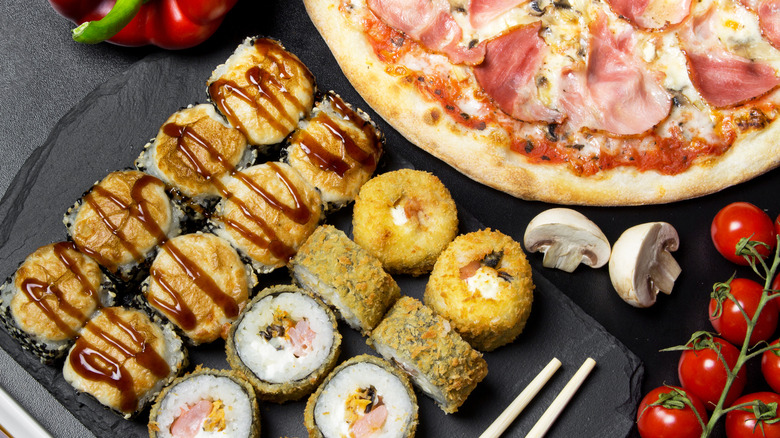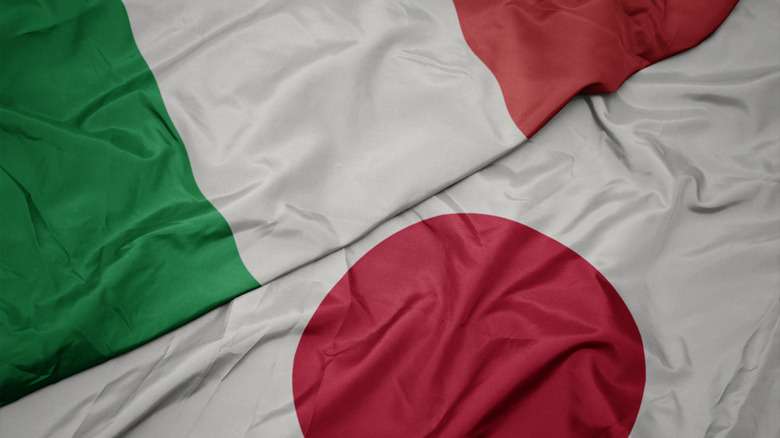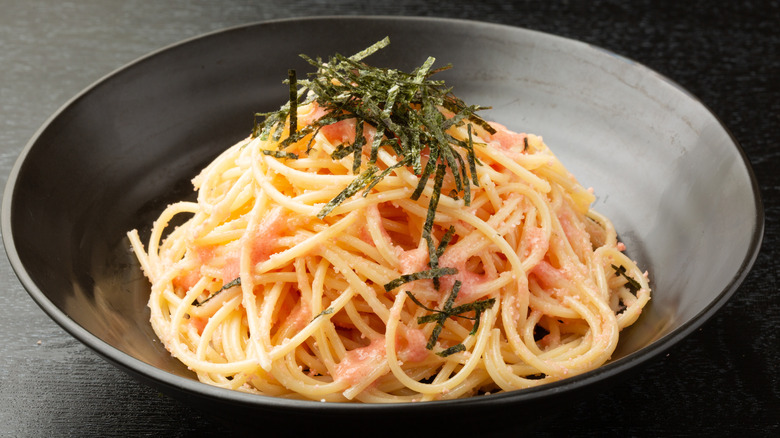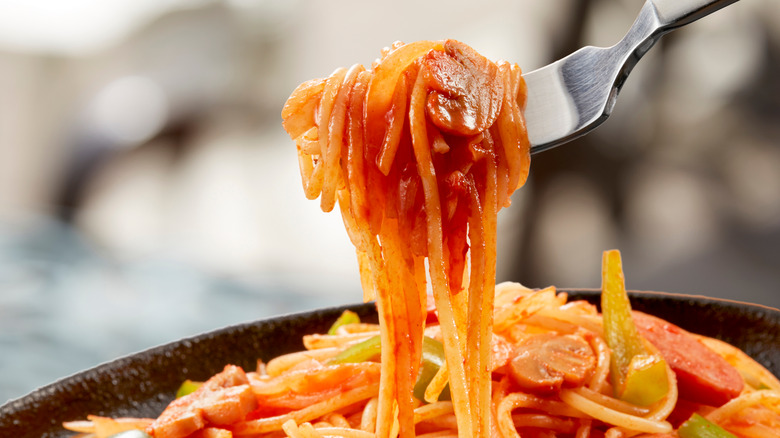Itameshi: The Meeting Point Between Italian And Japanese Cuisines
Japanese cuisine is known for being intricately made and full of unique umami flavors. When visiting the country, traditional Japanese foods like sushi or ramen may be the first bites you think about taking. After all, these dishes are not only icons within Japan but have made a name for themselves around the globe. While it is undeniable that sushi and ramen are uniquely Japanese, the nation's fusion foods are also one of a kind.
You may have heard of yōshoku, the name for Japan's Western fusion food adoptions. From omurice, a thin omelet with a runny inside placed on top of a bed of ketchup-y rice, to hambāgu, the nation's take on a hamburger, plenty of these Western-style dishes have taken the country by storm. The history of this fusion food dates back to the late 19th century. During this era, Japan opened its borders to trade, which prompted a rapid integration of Western elements, according to the culture magazine Japan Objects. However, there is a genre of Japanese fusion food that has narrowed in on one Western nation in particular: Italy.
According to Let's Visit Asia, itameshi is Japanese for "Italian Food." While the word does refer to authentic Italian cuisine, it also describes the country's Japanese-Italian fusion food genre. The popularity of this food has increased over the years, and it all started in the early 20th century.
What is itameshi?
Spaghetti is one of the most prominent foods served in this fusion genre, and it was first popularized in Japanese cafes in the 1920s, according to The Atlantic. The site notes that during this time period, Italian-American GIs in the country were eating Italian red sauce, which was many Japanese people's first introduction to Italian food. A bigger craze for spaghetti struck the country in the 1990s when fancier restaurants switched from focusing on French food to Italian. The Atlantic attributes this switch in taste due to various economies of Asia experiencing economic crashes. Italian cuisine was perceived as warm, affordable, and upbeat in contrast to the formality and expense of French cuisine.
Aside from spaghetti, Eater notes that Japan also largely enjoys espresso and pizza culture. Similarly, common pizza ingredients, like garlic and tomato, have started making their way into the country's ramen.
Eater adds that this cuisine combination was likely destiny, as both countries "embrace almost microscopic regionalism" and have strict standards on both of their cuisine's ingredients and techniques.
Ashley Rose Young, a food historian at the Smithsonian, told the outlet, "Itameshi is a fantastic combination, and we know that because it already exists in the culture with dishes like ramen that could become Italian with just a small twist."
The best itameshi dishes
Let's Visit Asia notes that wafu spaghetti is a popular meal within this fusion food genre. As per the site, many concepts from Western culture that have been adapted to the Japanese culture are collectively referred to as wafu, which translates to "Japanese Style."
This broad term includes several spaghetti meals that are inspired by Italian culture. For example, tarako spaghetti, as pictured above, is a pasta dish that features pollock roe. Tarako translates to "pollock roe," which is highlighted in this dish's decadent sauce, along with butter, soy sauce, and shredded nori.
Another popular wafu spaghetti, as per Let's Eat Asia, is Napolitan spaghetti. This dish showcases only Western ingredients, with the lineup typically including ketchup, bacon, onions, and mushrooms tossed with the pasta. Occasionally, a fried egg also makes an appearance atop this dish.
A similar endless amount of Japanese pizza options exist as well. From okonomiyaki ingredients making a doughy debut to teriyaki chicken taking pepperoni's place, Japanese pizza is a beautifully balanced indulgence that calls out to be tried by passers-by.
As Eater points out, Kimika, a New York City restaurant is one of the leading itameshi establishments in the U.S. According to the site, the menu includes items such as the "crispy panko-crusted eggplant katsu to bomboloncini, a playful combination that combines fried Italian doughnuts with mochi along with Nutella, toasted sesame, and hazelnut." But that's not the only state-side establishment where one can enjoy creative itameshi dishes.
Where to eat itameshi
In Japan, it seems many itameshi dishes can be traced back to a unique restaurant where they were first invented. If you're interested in some restaurant hopping that allows you to experience a number of different wafu spaghetti dishes, for example, it will take some dedication since there are so many distinct dishes. However, it may not be impossible.
As Let's Visit Asia notes, tarako spaghetti originated at the Kabe No Ana restaurant in the Shibuya district of Tokyo. Supposedly, the dish was invented when customers asked the chefs at the establishment to add caviar to their spaghetti, resulting in a tasty new dish. However, since caviar was too expensive for Kabe No Ana to keep tossing into pasta, pollock roe was supplemented. Another popular wafu spaghetti dish, Napolitan spaghetti, was created just an hour away at the New Grand Hotel in Yokohama right after World War two, as per the site.
However, if taking a trip to Japan is not on your calendar anytime soon, there are plenty of stateside establishments to experience the unique cuisine. According to Eater, Kimika is dedicated to itameshi cuisine and is located on Kenmare Street near Bowery in New York City. While it was not the first place to dole out the stuff, it is definitely the most well-known.
If you're in the mood for some distinctly delicious fusion food, discovering one of these locations might be the best decision you've ever made.



